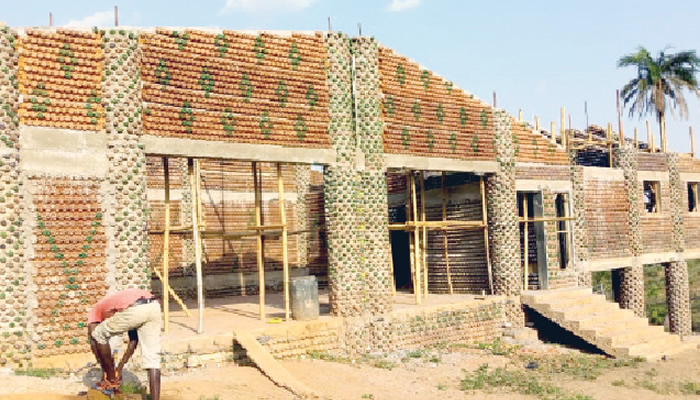Yahaya Ahmed, director at the Developmental Association of Renewable Energies, speaks with BIODUN BUSARI about the achievements and obstacles encountered in constructing homes using plastic bottles within the nation.
What
What was it like constructing the initial house using 14,800 sand-filled plastic bottles?
Well, at that time, it was even relatively easier to get the bottles because they were all scattered everywhere. The whole idea was that we had, on one side, boys who were idle and jobless, just begging on the streets. They were approached and convinced to pick bottles for us. In addition, I thought it worked well.
Where did you acquire your knowledge of this technology?
I acquired the knowledge of this technology or process directly from its inventor during my time in Germany. Consequently, we arranged for his visit through several non-governmental organizations so he could instruct us locally. After receiving training from him, we began collecting bottles from ditches and fields. This marked the beginning of our journey towards constructing the initial prototype.
Starting from there, we trained several individuals, and a handful became intrigued. Gradually, we started securing various contracts to construct different projects. Currently, due to the implementation of recycling—a significant benefit for our nation—plastic bottles have turned into highly valued commodities. These items are now collected by nearly everyone, particularly those who scavenge for recyclables.
Nevertheless, not every bottle gets recycled; some end up being discarded when potential purchasers cannot be found. Currently, acquiring these materials remains simpler if purchased directly from collectors. In the past, gathering and assembling everything required significant effort as we needed to search far and wide. Today, however, one can simply source bottles from various collectors instead. While this option isn’t costly, I believe it serves as a viable substitute for conventional concrete bricks.
How consistently have you performed since the initial structure?
The initial project took place around 2012 or 2013. However, since then, we’ve continued to develop more initiatives. Our most recent effort concluded in March when we constructed a public restroom at a community school located in Kaduna. This particular institution lacked facilities altogether, hence our construction of a four-unit bathroom complex for their use. This initiative also serves a community school based in Kaduna.
How many bottles was it priced at?
Approximately 8,000 bottles were utilized for this initiative. A group of Sociology students from Ahmadu Bello University orchestrated the project; they handled the financing, while we supplied the labor force.
What steps should one take to secure contracts?
Primarily, individuals contact us with inquiries, and often they ask about constructing something similar. We usually offer two choices: first, gather sufficient bottles. Based on their construction goals, we supply an approximate number of bottles required for the project.
The customer supplies the bottles through buying or collecting them. Afterward, we handle the rest. We establish the cost, followed by beginning to fill the bottles with sand. The contents include a blend of laterite and fine sand, which is packed tightly together.
The most challenging and lengthy aspect of the process is the filling stage since we handle everything manually. Following this, we install all additional components like doors, windows, and interior finishes. Our role primarily involves constructing the basic framework. The necessary funds for these projects come from organizations and individuals with specific needs.
Will people continue working alongside you following the training?
Not necessarily, as we aren’t able to hire them permanently. Following their training, we seek out those who are available during periods of high demand. When a new project arises, we reach out to them. In the meantime, they often search for projects independently too. However, after providing training, we cannot guarantee employment or retention for them.
Does the government or its agencies provide support?
The government, at both the state and local levels, offers no backing for these initiatives. In contrast, individuals abroad place great importance on them. This lack of support stems from their belief that such projects do not offer practical solutions.
A specific deputy governor, who would go on to become a governor, frankly informed me that the concept wasn’t feasible. In response, I pointed out that there were ample opportunities for collecting discarded bottles, particularly in Kaduna, making such an initiative viable and effective. Despite my attempts to persuade him of the benefits of using plastic bottles as construction materials, he remained unconvinced with this proposal.
Whenever it rains for about 30 minutes, nearly half of the city ends up inundated. This occurs due to an inadequate drainage system choked with plastic bottles. While organic waste can flow through the water, these bottles remain intact without decomposing; they simply block the channels instead. Consequently, our efforts primarily involve working alongside individual citizens and various non-governmental entities.
What is the total number of individuals you have trained since your organization was established?
We conduct training sessions for groups. So far, we’ve conducted a session with 50 participants, which has been repeated around four times. Our group size never exceeds 50 individuals. Additionally, we work with interlocking tiles. These tiles often incorporate materials like soft plastic from packaging bread—such as nylon bags—in their production process.
Whenever individuals or organizations sponsor us, we can train additional people. At one point, we received an invite from Ogun State, who sent ten participants our way for a project training session. These attendees stayed with us in Kaduna for roughly two months.
How many homes has your plastic bottle initiative constructed so far?
So far, we have completed construction of up to 15 homes. Some were erected in Kano, with others located in Kaduna. Specifically in Kaduna, we currently have three finished units. Among these constructions, our initial project involved building not only the primary residence but also adding a communal restroom and a smaller structure nearby. Additionally, we successfully developed a fully-finished home in Ibadan; this particular property consists of three bedrooms and serves dual purposes as both workspace and living quarters today.
In Abuja, we constructed a five-bedroom duplex. This isn’t just limited to building smaller bungalows; you can also create multi-story buildings. Similar constructions were undertaken in Port Harcourt and various key locations across the nation. Beyond Nigeria, a paramount chief from Ghana came across our work on YouTube and requested our expertise for some training sessions.
It took roughly four and a half months to train around 15 individuals from his community in a village close to Kumasi. Following the training sessions, we constructed several facilities for their education. From what I understand, they are currently erecting a palace and utilizing plastic bottles for fencing purposes. This project seems to be progressing accordingly.
What advantages do these plastic bottles offer?
There are numerous advantages. Primarily, consider the economic aspect. This method is more affordable than using concrete or ceramic materials. The expense can be roughly half that of constructing a home with sand or clay, or potentially even lower, depending on how many bottles are collected. Should the sand extracted from the site prove suitable, we utilize it both for filling the bottles and as an adhesive substance.
If the soil is suitable, we utilize it; otherwise, we purchase laterite to blend with it. Thus, nothing goes to waste. Typically, builders discard the sand or clay extracted from the foundation instead of using it for construction. However, we adopt a different approach. We collect this sand, process it by sieving out large rocks which we then use as filler material inside bottles, thereby putting everything to good use.
At what point do you begin using cement?
Except for the foundation, which varies based on soil conditions, we avoid using any cement. It’s only used to strengthen the foundation. Typically, this involves adding a layer between 5 to 10 centimeters thick, followed by a concrete layer. The process begins with laying down the bottles as part of the foundation but doesn’t involve cement afterward. Cement does come into play when applying plaster at the end though.
Leaving it as it is would make it look even more stunning, but we must cover it due to rainfall. Additionally, the secondary benefit lies in environmental contributions. By using bottles for construction, you help cleanse the surroundings. This process isn’t just about recycling; it involves upcycling.
In some recycling processes, the bottles can be turned into something else, but they become waste again and go back into the waste dump. Recycling will come back into the system. If you cannot recycle it again, it goes into the waste dump. But this one is upcycling—it doesn’t come back again. Another advantage is that it is more durable than cement blocks.
For how long can the sand-filled plastic bottle structures endure?
If you return in 200 or 250 years, plastic bottle structures will remain intact. Without an explosion or similar destructive force, these buildings would persist for centuries. They also regulate temperature naturally. Particularly in northern regions during the harmattan season, when it’s chilly outdoors, inside remains comfortably warm.
During the scorching months, temperatures can soar up to nearly 40 degrees outdoors. However, once inside, it feels much cooler—at most around 26 degrees. You might not require an air conditioner at all. For additional comfort, simply use a ceiling fan or a portable one instead.
It also offers bullet resistance. While bullets from an AK-47 can go through sandcrete blocks, they cannot get past sand-filled plastic bottles without using explosives. This is similar to how military checkpoints employ sand for protection; they utilize sand as a barrier.
What difficulties have you faced since beginning this journey?
The primary obstacle is securing backing from officials. Additionally, obtaining construction permits in certain areas poses another hurdle. There are locations where the concept remains misunderstood, leading them to refuse approval for permits altogether.
A further obstacle lies in raising awareness about replacing mud houses in rural areas with sand-filled plastic bottles. Additionally, we lack funds for this initiative. These mud structures often crumble during rainfalls. The issue encompasses multiple aspects ranging from government bodies to community members.
Do rivalries exist among stakeholders involved in sandcrete or block construction?
For now, this issue isn’t very common. This is why they haven’t developed significant competition yet. Perhaps it might happen down the line, but currently, things haven’t reached a point where others are vying against us. However, some individuals commented earlier that we were attempting to undermine sandcrete building marketing efforts. We simply dismissed those comments with laughter.
The true challenge arises with regard to interlocking. This is solely because our interlocking products are more affordable and robust compared to those made from cement. We’re already encountering this issue.
Provided by SyndiGate Media Inc.
Syndigate.info
).





